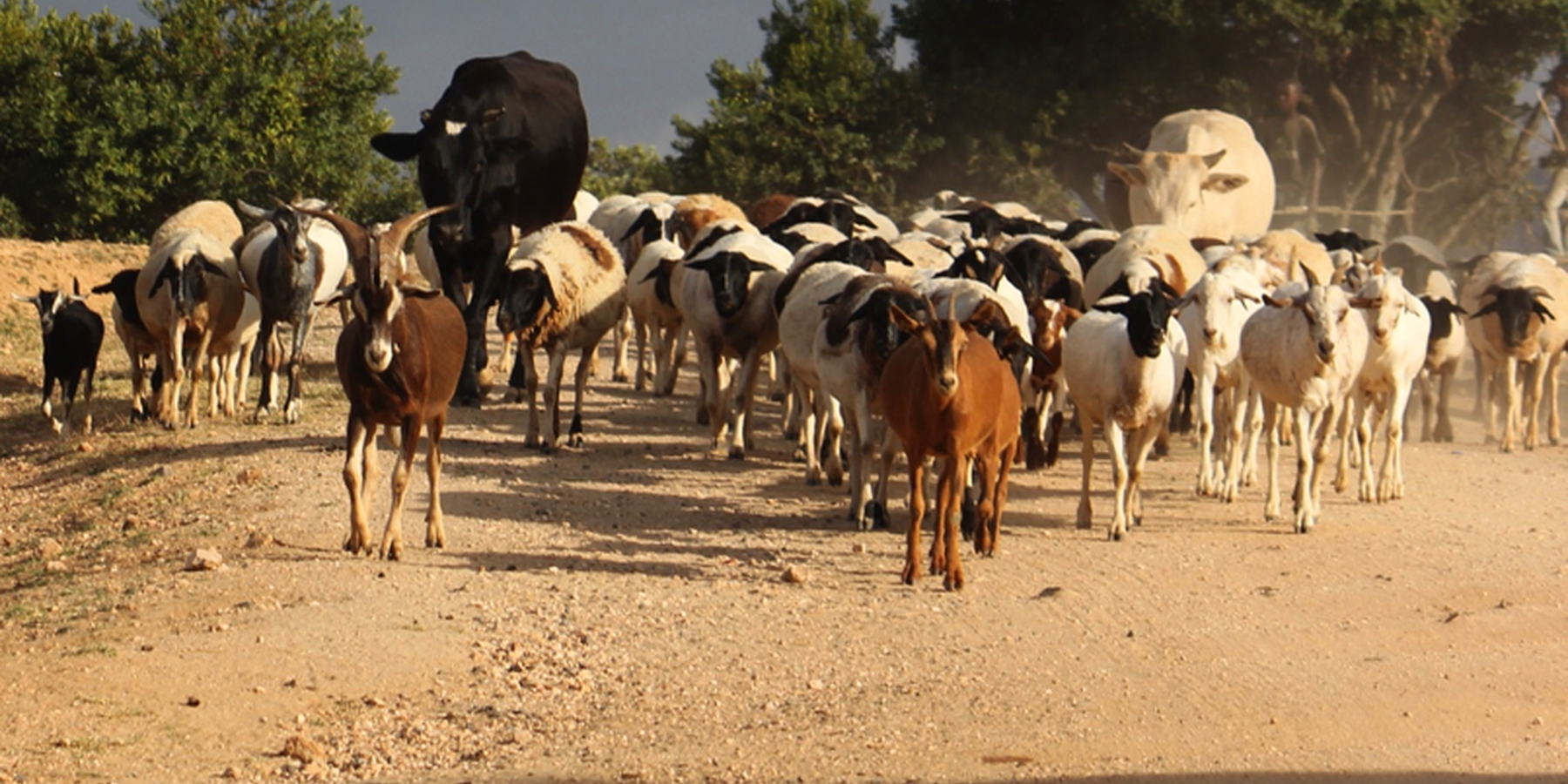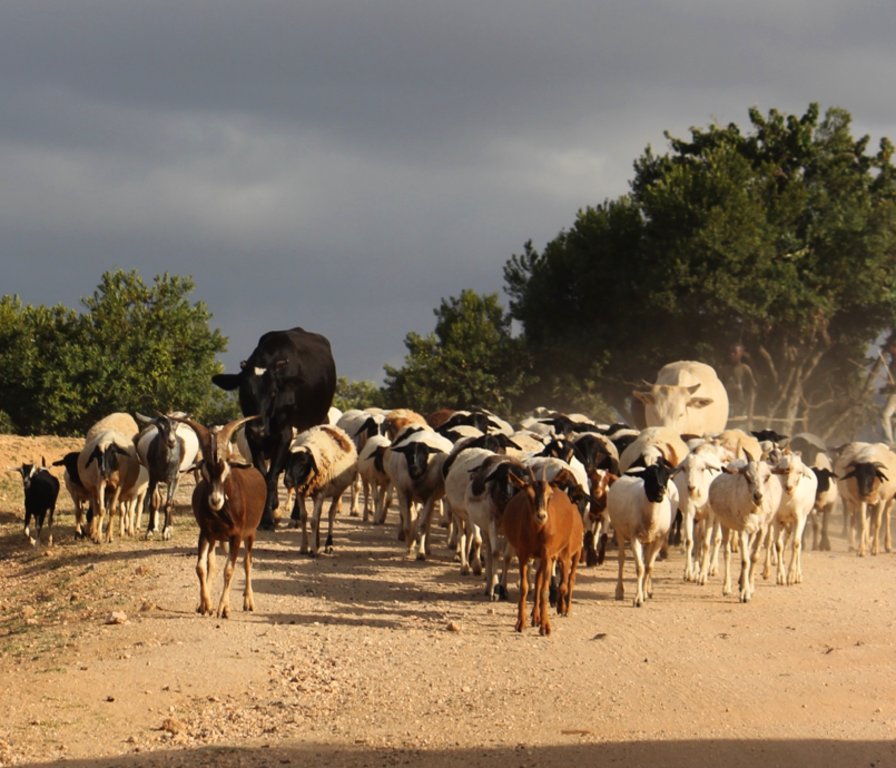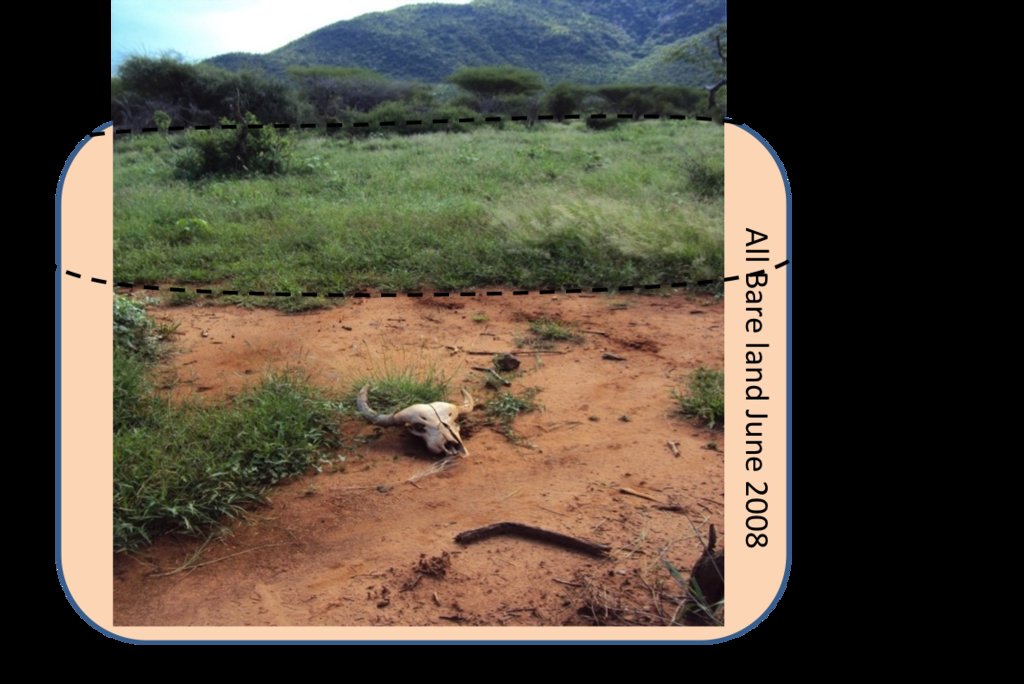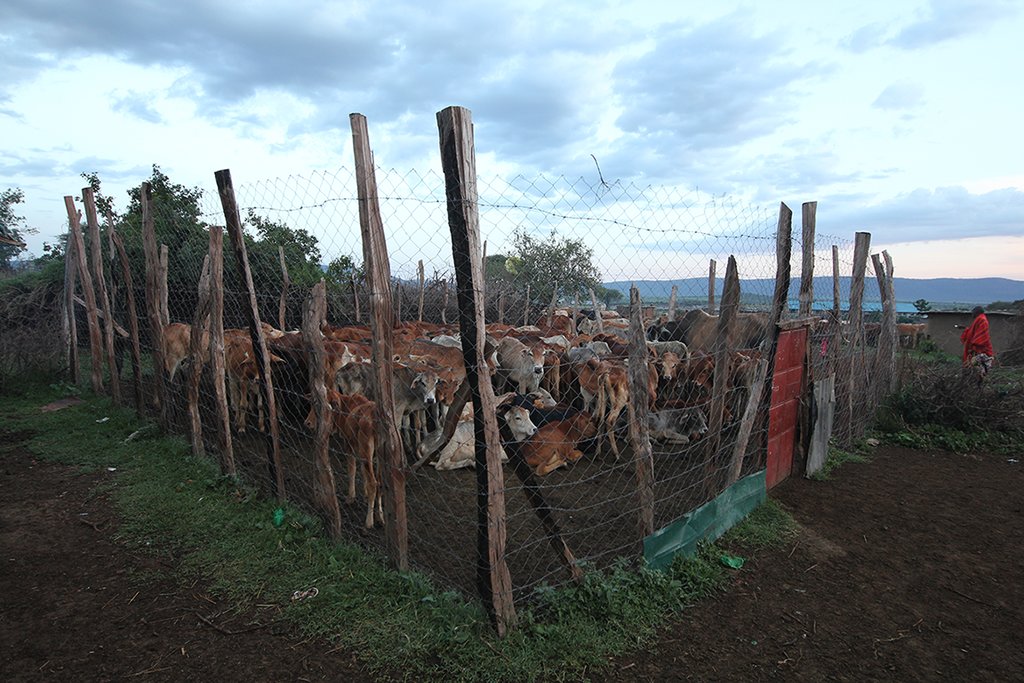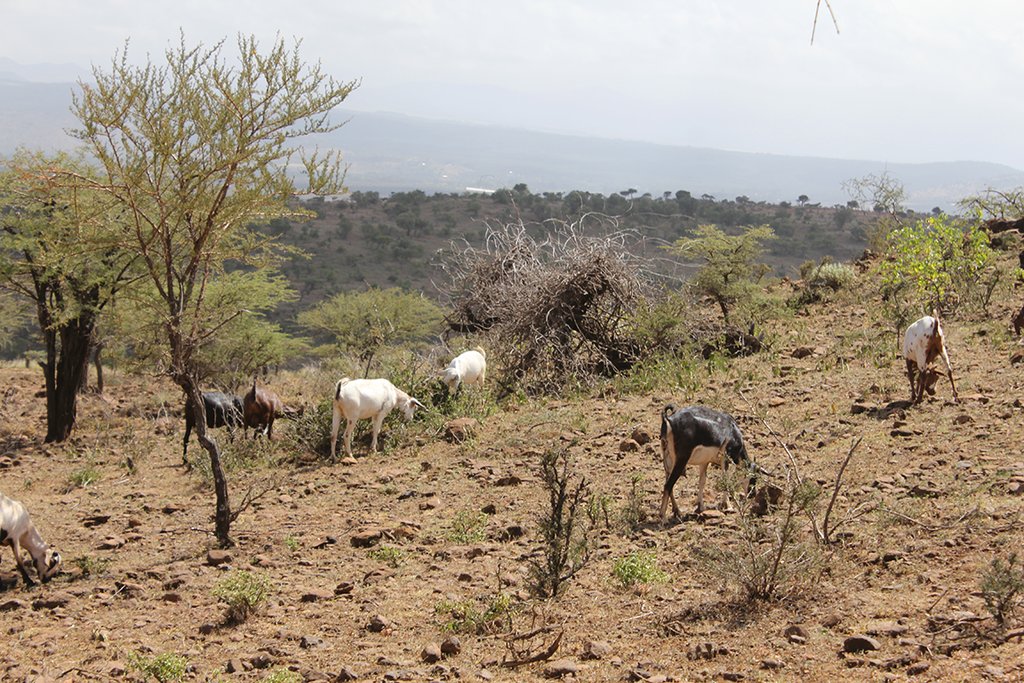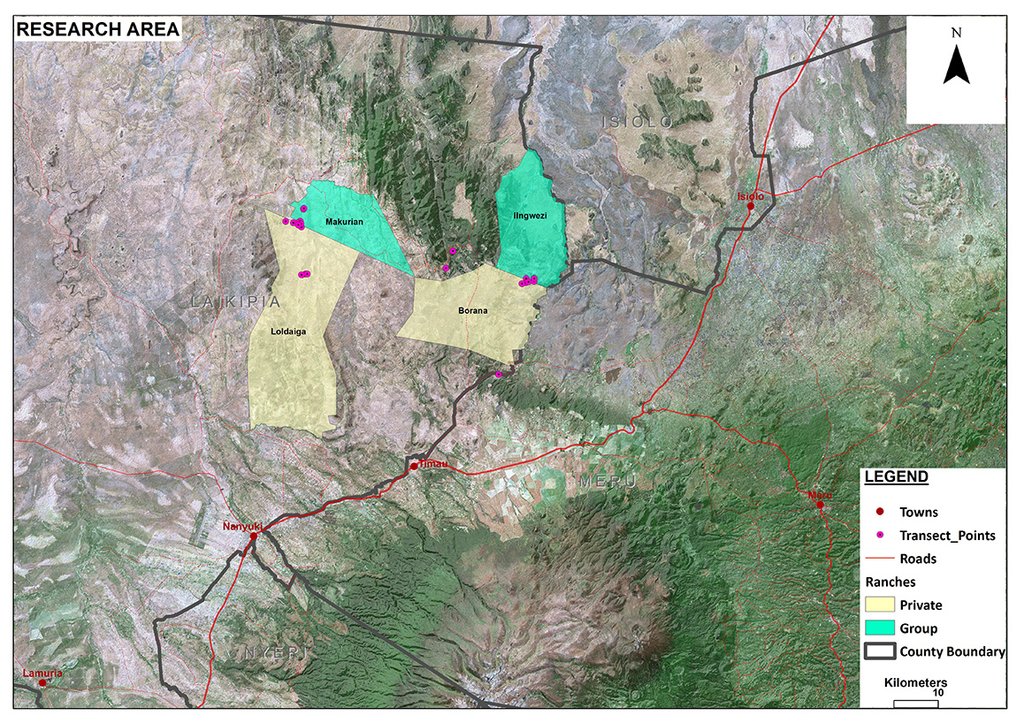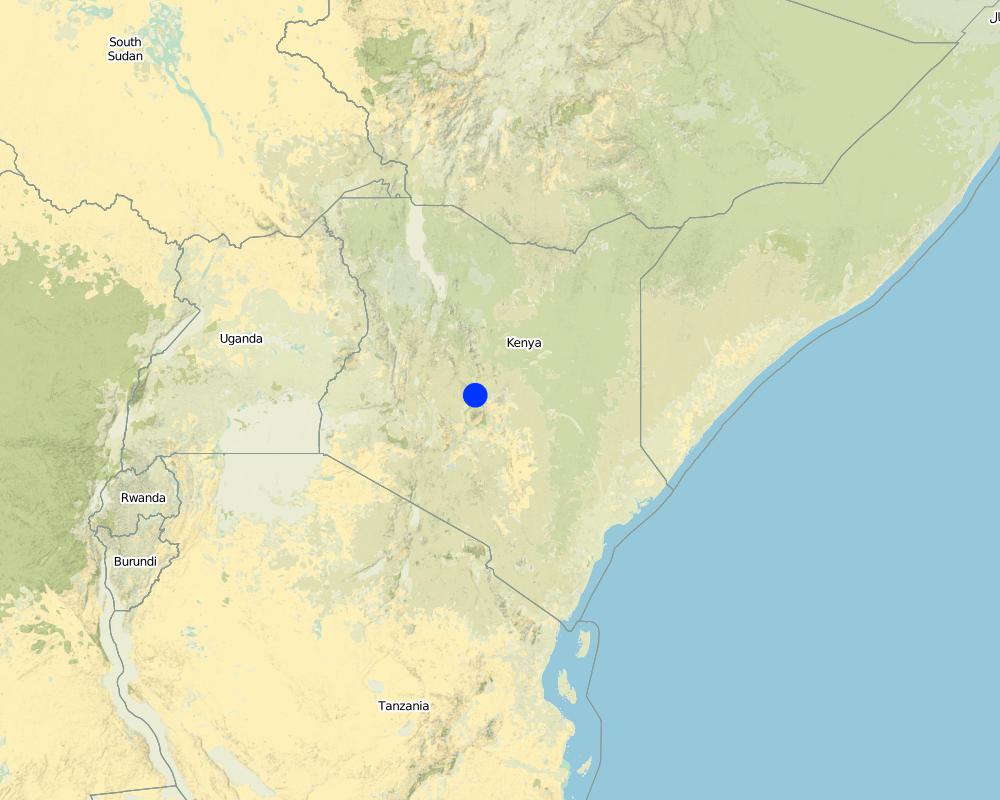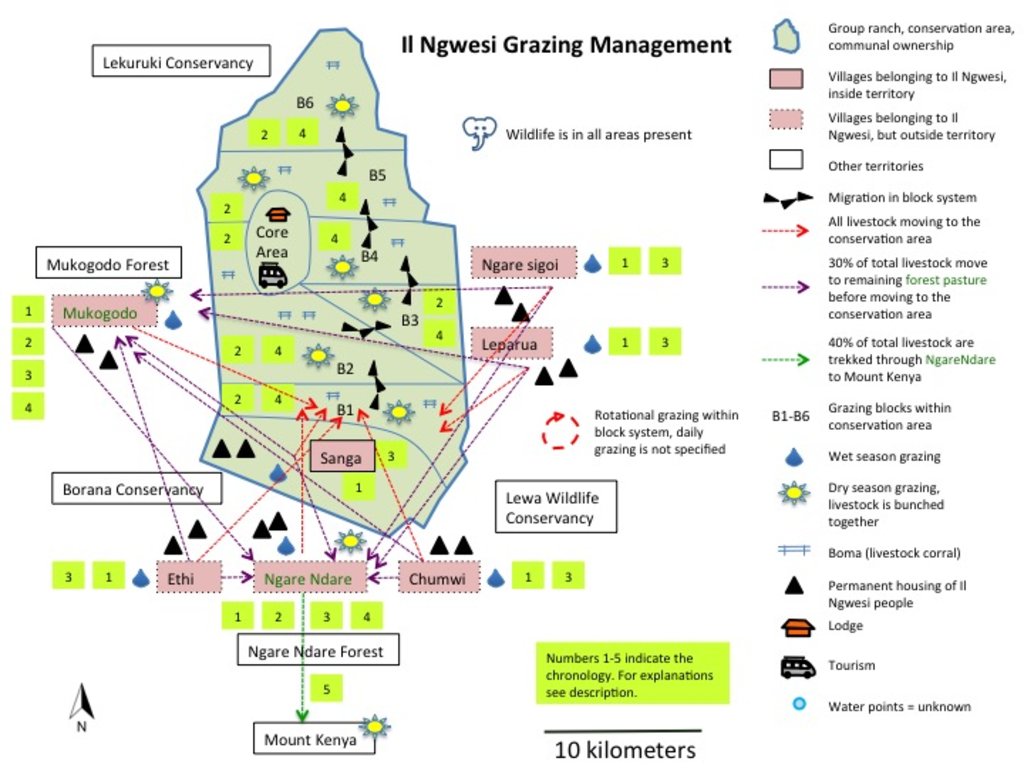Il Ngwesi Group Ranch Grazing with Holistic Management Principles [ເຄັນຢາ]
- ການສ້າງ:
- ປັບປູງ:
- ຜູ້ສັງລວມຂໍ້ມູນ: Michael Herger
- ບັນນາທິການ: –
- ຜູ້ທົບທວນຄືນ: Donia Mühlematter, Brigitte Zimmermann, Rima Mekdaschi Studer, Alexandra Gavilano, Hanspeter Liniger
technologies_2092 - ເຄັນຢາ
- ສະຫຼຸບສັງລວມຢ່າງທັງໝົດທີ່ເປັນ PDF
- ສັງລວມເປັນບົດ PDF ເພື່ອສັ່ງພິມ
- ສັງລວມເປັນບົດ ຢູ່ໃນ browser
- ບົດສະຫຼຸບ ສະບັບເຕັມ (ບໍ່ມີແບບຟອມ)
- Il Ngwesi Group Ranch Grazing with Holistic Management Principles: Sept. 4, 2019 (inactive)
- Il Ngwesi Group Ranch Grazing with Holistic Management Principles: Feb. 22, 2018 (inactive)
- Il Ngwesi Group Ranch Grazing with Holistic Management Principles: July 11, 2018 (inactive)
- Il Ngwesi Group Ranch Grazing with Holistic Management Principles: Sept. 3, 2018 (inactive)
- Il Ngwesi Group Ranch Grazing with Holistic Management Principles: Oct. 4, 2018 (inactive)
- Il Ngwesi Group Ranch Grazing with Holistic Management Principles: Nov. 2, 2021 (inactive)
- Il Ngwesi Group Ranch Grazing with Holistic Management Principles: Nov. 2, 2021 (public)
- Il Ngwesi Group Ranch Grazing with Holistic Management Principles: Feb. 1, 2018 (inactive)
ເບິ່ງພາກສ່ວນ
ຂະຫຍາຍທັງໝົດ ຍຸບທັງໝົດ1. ຂໍ້ມູນທົ່ວໄປ
1.2 ຂໍ້ມູນ ການຕິດຕໍ່ພົວພັນ ຂອງບຸກຄົນທີ່ສໍາຄັນ ແລະ ສະຖາບັນ ທີ່ມີສ່ວນຮ່ວມ ໃນການປະເມີນເອກກະສານ ເຕັກໂນໂລຢີ
ບັນດາຜູ້ຕອບແບບສອບຖາມທີ່ສໍາຄັນ ()
ຜູ້ນໍາໃຊ້ທີ່ດິນ:
Leresi Patrick
+254721153572
ilngwesi@nrt-kenya.org
Il Ngwesi Group Ranch
Mukogodo Division, Laikipia North District, PO Box 263, 1042 Timau, Kenya
ເຄັນຢາ
1.3 ເງື່ອນໄຂ ກ່ຽວກັບ ການນໍາໃຊ້ຂໍ້ມູນເອກະສານ ທີ່ສ້າງຂື້ນ ໂດຍຜ່ານ ອົງການພາບລວມຂອງໂລກ ທາງດ້ານແນວທາງ ແລະ ເຕັກໂນໂລຢີ ຂອງການອານຸລັກ ທໍາມະຊາດ (WOCAT)
ເມື່ອໃດທີ່ໄດ້ສັງລວມຂໍ້ມູນ (ຢູ່ພາກສະໜາມ)?
22/01/2017
ຜູ້ປ້ອນຂໍ້ມູນ ແລະ ບຸກຄົນສຳຄັນ ທີ່ໃຫ້ຂໍ້ມູນ (ຫຼາຍ) ຍິນຍອມ ຕາມເງື່ອນໄຂ ໃນການນຳໃຊ້ຂໍ້ມູນ ເພື່ອສ້າງເປັນເອກກະສານຂອງ WOCAT:
ແມ່ນ
1.4 ແຈ້ງການວ່າ ດ້ວຍຄວາມຍືນຍົງຂອງ ເຕັກໂນໂລຢີ
ການນໍາໃຊ້ ເຕັກໂນໂລຢີ ດັ່ງກ່າວໄດ້ອະທິບາຍ ເຖິງບັນຫາ ກ່ຽວກັບ ການເຊື່ອມໂຊມຂອງດິນບໍ? ຖ້າບໍ່ດັ່ງນັ້ນ ມັນບໍ່ສາມາດ ຢັ້ງຢືນໄດ້ວ່າ ເປັນເຕັກໂນໂລຊີ ໃນການຄຸ້ມຄອງ ທີ່ດິນແບບຍືນຍົງ? :
ບໍ່ແມ່ນ
ຄວາມຄິດເຫັນ:
Yes and no, only time will tell here. Grazing principles and management (with partly applied Holistic Managment) of Il Ngwesi Group Ranch are said to be exemplary for group ranches in the area. In evaluation processes since the introduction of the new principles and also in reports, they were rated as "best practice". Land recovery is according to these reports in full swing. However, in the field the picture looks partially different. The land is in large areas (still) heavily degraded. Data suggests that vegetation and soil is in a rather bad condition - many erosion features characterize the land. Nevertheless, according to land users, land coverage has significantly improved since the introduction of the new technologies.
2. ການອະທິບາຍ ເຕັກໂນໂລຢີ ຂອງການຄຸ້ມຄອງ ທີ່ດິນແບບຍືນຍົງ
2.1 ຄໍາອະທິບາຍສັ້ນຂອງ ເຕັກໂນໂລຢີ
ການກຳໜົດຄວາມໝາຍ ຂອງເຕັກໂນໂລຢີ:
A group ranch belonging to the Masai (traditionally, nomad pastoralists) has applied "Holistic Management" grazing principles. The principles consist of separate, planned grazing in villages during the rains, then “bunching” and moving of all animals in herds during the dry season. Denuded land is recovered by a "Boma” technology: i.e. strategic corralling of animals overnight, and reseeding.
2.2 ການອະທິບາຍ ລາຍລະອຽດ ຂອງເຕັກໂນໂລຢີ
ການພັນລະນາ:
On Il Ngwesi Masai Group Ranch, livestock production management is a combination of traditional livestock keeping and holistic grazing management principles which were introduced in 2007. Livestock production at Il Ngwesi is for subsistence and sales - and has very high cultural significance. 80% of the land is used for conservation, where wildlife and their habitat are protected. The vision is to integrate community development and sustainable environmental management. Holistic Management (HM) was originally conceived by Allan Savory (1988), and is promoted by the Laikipia Wildlife Forum. It integrates decision-making, planning, and livestock keeping. On the land, this means bunching of all livestock close together (in order to act as a "plough" and break the soil to allow seeds, nutrients, and water to infiltrate) resulting in better plant growth. By moving the animals together from block to block, HM aims at managing high numbers of livestock while restoring degraded land. Instead of individual livestock-owning families herding and trekking their own animals, consolidated herds are now managed and moved together, and overseen by herders and supervisors. This allows intensive grazing in restricted areas while resting the remaining land - instead of continuous open grazing. However, Holistic Management principles are still a matter of controversy. While advocates of these management principles do not limit herd sizes, opponents see the root cause of degradation exactly in too high stocking rates. Criticism is plentiful and reviews of the method state that there are no peer-reviewed studies that prove that Holistic Management is superior to conventional grazing systems in outcomes (Carter et al. 2014, Briske et al. 2014).The group ranch land consists of a settlement and a conservation area. The conservation area is further subdivided into a small core zone, measuring 500 hectares and a larger buffer zone of 6,000 hectares. Within this buffer zone, pastoralists are permitted to graze livestock during the dry season.Besides these two main grazing areas in their group ranch, they use additional grazing areas outside their territory such as pasture in forests. In one forest - Mukogodo - they have settled officially; in Ngare Ngare and on Mount Kenya, on the other hand, it is more of an informal agreement. In Il Ngwesi, HM principles are very strictly applied in the conservation area; elsewhere only partly or not at all. During the movements to the forest glades and Mount Kenya, HM principles are maintained as far as possible. This documentation describes the combined grazing management system. During the rains, the grazing system is largely by traditional management: animals remain in and around villages managed individually by households. During the dry season, all livestock are bunched together and managed as one herd.During the wet season, grazing at Il Ngwesi Group Ranch is organized by elders within their seven villages. HM principles are only partly applied. During the dry season, once all the grazing land is eaten, livestock are bunched together and managed by a few herders and overseers. The block system rotation starts. To seek new pasture and water, cattle and smallstock are led to forest glades, and then to the Il Ngwesi conservation area. As soon as the forest pasture is gone, they move on to the conservation area. Usually, this movement of livestock to forests and conservation area starts in February; then they return to the villages in April; and then back to the forests and conservation area until the next rains in November. Whilst the livestock are bunched together, large bomas (corrals in Kiswahili) are constructed for overnight enclosure. Bomas are sited on bare land where dung accumulation and crust breaking by hooves helps rehabilitate land. Every year the boma sites are shifted slightly according to a plan. The total area that can be restored per year is almost 1% of the area of Il Ngwesi.
2.3 ຮູບພາບຂອງເຕັກໂນໂລຢີ
2.5 ປະເທດ / ເຂດ / ສະຖານທີ່ບ່ອນທີ່ ເຕັກໂນໂລຢີ ໄດ້ຮັບການນໍາໃຊ້ ແລະ ທີ່ຖືກປົກຄຸມດ້ວຍການປະເມີນຜົນ
ປະເທດ:
ເຄັນຢາ
ພາກພື້ນ / ລັດ / ແຂວງ:
Laikipia
ຂໍ້ມູນເພີ່ມເຕີມຂອງສະຖານທີ່:
Mukogodo Divison
Map
×2.6 ວັນທີໃນການຈັດຕັ້ງປະຕິບັດ
ໃຫ້ລະບຸປີ ໃນການຈັດຕັ້ງປະຕິບັດ:
2007
2.7 ການນໍາສະເໜີ ເຕັກໂນໂລຢີ
ໃຫ້ລະບຸ ເຕັກໂນໂລຢີ ໄດ້ຖືກຈັດຕັ້ງປະຕິບັດຄືແນວໃດ?
- ເປັນສ່ວນໜື່ງຂອງລະບົບພື້ນເມືອງ (>50 ປີ)
- ໂດຍຜ່ານໂຄງການ / ການຊ່ວຍເຫຼືອຈາກພາຍນອກ
ຄວາມຄິດເຫັນ (ປະເພດ ໂຄງການ ແລະ ອື່ນໆ):
Holistic Management approach by Allan Savory.
In Laikipia, it was introduced by Richard Hartfield, Laikipia Wildlife Forum and funded by Laikipia Wildlife Forum (LWF), Lewa Conservancy and Northern Rangeland Trust (NRT) (approximately 50% of all additional costs of Il Ngwesi since the implementation were covered by funding). Agreement with elders was reached first, then the community was trained.
3. ການໃຈ້ແຍກ ເຕັກໂນໂລຢີ ໃນການຄຸ້ມຄອງ ດິນແບບຍືນຍົງ
3.1 ຈຸດປະສົງຫຼັກ (ຫຼາຍ) ຂອງເຕັກໂນໂລຢີ
- ປັບປຸງ ການຜະລິດ
- ຫຼຸດຜ່ອນ, ປ້ອງກັນ, ຟື້ນຟູ ການເຊື່ອມໂຊມຂອງດິນ
- ການອະນຸລັກ ລະບົບນິເວດ
- ປົກປັກຮັກສາ / ການປັບປຸງຊີວະນາໆພັນ
3.2 ປະເພດການນໍາໃຊ້ທີ່ດິນ ໃນປະຈຸບັນ() ທີ່ເຕັກໂນໂລຢີ ໄດ້ຖືກນໍາໃຊ້

ທົ່ງຫຍ້າລ້ຽງສັດ
ທົ່ງຫຍ້າລ້ຽງສັດທໍາມະຊາດ:
- ແບບເຄິ່ງຂັງ / ເຄິ່ງປ່ອຍ
ຊະນິດພັນສັດຕົ້ນຕໍ ແລະ ຜະລິດຕະພັນ:
Livestock: Cattle, goats, sheep, donkeys, camels
Meat and milk production (also blood) and as a bank/ value asset. Mainly subsistence and local production.
Livestock: 4’800 TLU; Stocking rate: 3.3 ha/TLU (calculated with the total affected land by livestock: 157km2)
Pressure on land including wildlife: 3.3 ha/TLU (stays the same, calculated with wildlife biomass density estimated by Georgiadis et al. 2007).
Livestock numbers:
Lower Il Ngwesi: 4000 cattle, 20'000 shoats, 50 donkeys, 100 camels.
Sanga: 700 cattle, 2000 shoats, 20 donkeys.
Mukogodo: 1500 cattle, 5000 shoats, 20 donkeys
Livestock fluctuations (per year): -10% sales, -5% loss due to drought/diseases, -5% slaughtered,
+30% natural breeding, new purchase and deaths are mutually offsetting.
Steers are for fattening on private ranches and during droughts other livestock can be moved to private ranches (up to 3000).
Wildlife: elephant, antelope/ gazelle (like gerenuk, impala, Thomson's gazelle, dik-dik), hares, predators and more.

ການຕັ້ງຖິ່ນຖານ, ພື້ນຖານໂຄງລ່າງ
- ການຕັ້ງຖິ່ນຖານ, ອາຄານ
ຂໍ້ສັງເກດ:
Villages, bomas, manyattas.
8'000 inhabitans.
Lodge for Tourism.
3.3 ຂໍ້ມູນເພີ່ມເຕີມກ່ຽວກັບການນໍາໃຊ້ທີ່ດິນ
ການສະໜອງນໍ້າ ໃນພື້ນທີ່ ທີ່ໄດ້ນໍາໃຊ້ ເຕັກໂນໂລຢີ:
- ນໍ້າຝົນ
ຈໍານວນ ລະດູການ ປູກໃນປີໜຶ່ງ:
- 2
ລະບຸ ຊະນິດ:
Short rains in November and December. Long rains in April and May. Rains from (October) November to December are usually better in this area. Rainfalls with strong local variations and changing regimes.
ຄວາມໜາແໜ້ນ ຂອງສັດລ້ຽງ (ຖ້າຫາກວ່າກ່ຽວຂ້ອງ):
4’800 TLU; Stocking rate: 3.3 ha/TLU. Pressure on land: 3.3 ha/TLU
3.4 ການນໍາໃຊ້ເຕັກໂນໂລຢີ ທີ່ຢູ່ໃນກຸ່ມການຄຸ້ມຄອງ ທີ່ດິນແບບຍືນຍົງ
- ການຄຸ້ມຄອງສັດລ້ຽງ ແລະ ທົ່ງຫຍ້າລ້ຽງສັດ
- ການປັບປຸງດິນ / ພືດຄຸມດິນ
3.5 ການຂະຫຍາຍເຕັກໂນໂລຢີ
ໃຫ້ລະບຸ ການແຜ່ຂະຫຍາຍ ເຕັກໂນໂລຢີ:
- ແຜ່ຂະຫຍາຍຢ່າງໄວວາໃນພື້ນທີ່
ຖ້າຫາກວ່າ ເຕັກໂນໂລຢີ ໄດ້ແຜ່ຂະຫຍາຍທົ່ວພື້ນທີ່ືື ຢ່າງສະໜ່ຳສະເໝີ, ໃຫ້ລະບຸ ເນື້ອທີ່ ໂດຍການຄາດຄະເນ:
- 10-100 ກມ 2
ຄວາມຄິດເຫັນ:
Il Ngwesi has an area size of 87 km2. However, the total affected land by livestock is 157km2. The technology is also applied on other ranches (mainly private ranches, see the documentation for neighboring "Borana") in Mukogodo division.
3.6 ມາດຕະການ ການຄຸ້ມຄອງ ທີ່ດິນແບບຍືນຍົງ ປະກອບດ້ວຍ ເຕັກໂນໂລຢີ

ມາດຕະການ ທາງດ້ານການຄຸ້ມຄອງ
- M2: ການປ່ຽນແປງ ການຈັດການຄຸ້ມຄອງ / ລະດັບຄວາມໜາແໜ້ນ
- M4: ການປ່ຽນແປງ ໄລຍະເວລາ ໃນການຈັດຕັ້ງປະຕິບັດ ກິດຈະກໍາ
3.7 ປະເພດດິນເຊື່ອມໂຊມ ຫຼັກທີ່ໄດ້ນໍາໃຊ້ ເຕັກໂນໂລຢີ

ດິນເຊາະເຈື່ອນ ໂດຍນໍ້າ
- Wt: ການສູນເສຍຊັ້ນໜ້າດິນ / ການເຊາະເຈື່ອນຜິວໜ້າດິນ
- Wg: ການເຊາະເຈື່ອນຮ່ອງນ້ຳ / ຫ້ວຍ

ດິນເຊາະເຈື່ອນ ໂດຍລົມ
- ການສູນເສຍຊັ້ນໜ້າດິນ

ການເຊື່ອມໂຊມ ຂອງດິນ ທາງກາຍະພາບ
- Pc: ການອັດແໜ້ນ
- Pk: ການບັນເທົາ ແລະ ການປົກຄຸມຂອງເປືອກໂລກ
- Pi: ເນື້ອດິນ ທີ່ມີຂະໜາດນ້ອຍຫຼາຍ

ການເຊື່ອມໂຊມ ທາງຊີວະພາບ
- Bc: ການຫຼຸດຜ່ອນການປົກຫຸ້ມຂອງພືດ
- Bh: ການສູນເສຍ ທີ່ຢູ່ອາໃສ ຂອງສິ່ງທີ່ມີຊິວິດ
- Bq: ປະລິມານ / ອິນຊີວັດຖຸຫຼຸດລົງ
- Bs: ຄຸນນະພາບ / ການອັດແໜ້ນ ຂອງສາຍພັນຫຼຸດລົງ
- Bl: ການສູນເສຍ ຈຸລິນຊີໃນດິນ
ຄວາມຄິດເຫັນ:
Across the grasslands and rangelands an increase in bare land and bush has been a clear trend all over Laikipia for many years, both on community-owned lands and private ranches. Major identified ecological problems (partly) caused by livestock production are: bare ground, low contents of soil organic carbon and plant-available nutrients, soil erosion (sealing, crusting, rills and gullies, water flow patterns, sheet erosion, pedestals), poor soil properties, undesirable species, and (increasing) woody and invasive species. However, Il Ngwesi is not affected by the invasive species Opuntia stricta. For more information on rangeland health see Herger (2018). The technology aims at improving vegetation cover of the land and thereby reducing further degradation and restoring degraded land.
3.8 ການປ້ອງກັນ, ການຫຼຸດຜ່ອນ, ຫຼືການຟື້ນຟູຂອງການເຊື່ອມໂຊມຂອງດິນ
ໃຫ້ລະບຸ ເປົ້າໝາຍ ເຕັກໂນໂລຢີ ທີ່ພົວພັນ ກັບຄວາມເຊື່ອມໂຊມຂອງດິນ:
- ຫຼຸດຜ່ອນການເຊື່ອມໂຊມຂອງດິນ
- ການຟື້ນຟູ / ຟື້ນຟູດິນທີ່ຊຸດໂຊມ
4. ຂໍ້ກໍາໜົດ, ກິດຈະກໍາການປະຕິບັດ, ວັດຖຸດິບ, ແລະຄ່າໃຊ້ຈ່າຍ
4.1 ເຕັກນິກ ໃນການແຕ້ມແຜນວາດ ເຕັກໂນໂລຢີ
4.2 ການແຕ້ມແຜນວາດອະທິບາຍເຕັກນິກ
Grazing map of Il Ngwesi in Mukogodo Division
Grazing Principles:
- Rotational, planned grazing
- Bunching
- Resting periods for pasture
- Bomas for bare patches (night corrals)
Value Chain:
• Natural Breeding/buying (Ranches & individually)
• Grazing
o Settlement area (in red, during the wet season, until pasture is gone, organised by elders, bunching of all animals as soon as it gets dry)
o Mukogodo Forest / Ngare Ndare Forest (30% of total livestock, remainder to conservation area for grazing directly)
o Conservation area (6 blocks)
o Mukogodo Forest/Ngare Ndare Forest/Mount Kenya (Ngare Ndare Forest as corridor to Mount Kenya, about 40% of total livestock goes to Mount Kenya)
• Need-driven sales to local butcheries/NRT/Ranches
Il Ngwesi Masai also started to buy land outside their Group Ranch.
4.3 ຂໍ້ມູນທົ່ວໄປກ່ຽວກັບການຄິດໄລ່ປັດໃຈຂາເຂົ້າໃນການຜະລິດ ແລະ ມູນຄ່າອື່ນໆ
ລະບຸ ວິທີການ ຄຳໃຊ້ຈ່າຍ ແລະ ປັດໄຈນໍາເຂົ້າ ທີ່ໄດ້ຄິດໄລ່:
- ຕໍ່ຫົວໜ່ວຍ ທີ່ໄດ້ຈັດຕັ້ງປະຕິບັດ ເຕັກໂນໂລຢີ
ໃຫ້ລະບຸຫົວໜ່ວຍ:
Herders, animals treatment. For the whole area affected by livestock (157 km2)
ລະບຸ ສະກຸນເງິນທີ່ໃຊ້ສໍາລັບ ການຄິດໄລ່ຄ່າໃຊ້ຈ່າຍ:
- ໂດລາສະຫະລັດ
ລະບຸ ຄ່າຈ້າງ ຄ່າແຮງງານສະເລ່ຍ ຕໍ່ ວັນ:
USD 2.5
4.4 ການສ້າງຕັ້ງກິດຈະກໍາ
| ກິດຈະກໍາ | ປະເພດ ມາດຕະການ | ໄລຍະເວລາ | |
|---|---|---|---|
| 1. | Training of elders and community by project leaders | ການຈັດການຄຸ້ມຄອງ | |
| 2. | Grazing planning for bunched animals (livestock from all households) | ການຈັດການຄຸ້ມຄອງ | |
| 3. | Hiring herders, supervisors, watchmen etc | ການຈັດການຄຸ້ມຄອງ |
4.5 ຕົ້ນທຶນ ແລະ ປັດໄຈຂາເຂົ້າທີ່ຈໍາເປັນໃນຈັດຕັ້ງປະຕິບັດ
| ລະບຸ ປັດໃຈ ນໍາເຂົ້າ ໃນການຜະລີດ | ຫົວໜ່ວຍ | ປະລິມານ | ຕົ້ນທຶນ ຕໍ່ຫົວໜ່ວຍ | ຕົ້ນທຶນທັງໝົດ ຂອງປັດໃຈຂາເຂົ້າ ໃນການຜະລິດ | % ຂອງຕົ້ນທຶນທັງໝົດ ທີ່ຜູ້ນໍາໃຊ້ທີ່ດິນ ໃຊ້ຈ່າຍເອງ | |
|---|---|---|---|---|---|---|
| ແຮງງານ | Costs for establishment unknown |
ຄວາມຄິດເຫັນ:
Trainings were funded by NRT, LWF and Lewa Conservancy. No figures on this.
4.6 ບໍາລຸງຮັກສາ / ແຜນຈັດຕັ້ງປະຕິບັດ ກິດຈະກໍາ
| ກິດຈະກໍາ | ປະເພດ ມາດຕະການ | ໄລຍະເວລາ / ຄວາມຖີ່ | |
|---|---|---|---|
| 1. | Herders, supervisors, watchmen etc | ການຈັດການຄຸ້ມຄອງ | |
| 2. | Animal treatments (vaccination, spraying, injections) | ພືດ | |
| 3. | Planning activites | ການຈັດການຄຸ້ມຄອງ | |
| 4. | Boma Management (mainly movement of Bomas) | ການຈັດການຄຸ້ມຄອງ |
4.7 ຄ່າໃຊ້ຈ່າຍ ແລະ ປັດໄຈນໍາເຂົ້າທີ່ຈໍາເປັນສໍາລັບການບໍາລຸງຮັກສາກິດຈະກໍາ / ແຜນປະຕິບັດ (ຕໍ່ປີ)
| ລະບຸ ປັດໃຈ ນໍາເຂົ້າ ໃນການຜະລີດ | ຫົວໜ່ວຍ | ປະລິມານ | ຕົ້ນທຶນ ຕໍ່ຫົວໜ່ວຍ | ຕົ້ນທຶນທັງໝົດ ຂອງປັດໃຈຂາເຂົ້າ ໃນການຜະລິດ | % ຂອງຕົ້ນທຶນທັງໝົດ ທີ່ຜູ້ນໍາໃຊ້ທີ່ດິນ ໃຊ້ຈ່າຍເອງ | |
|---|---|---|---|---|---|---|
| ແຮງງານ | Herders, watchmen | Person-days | 250.0 | 540.0 | 135000.0 | 100.0 |
| ແຮງງານ | Supervisors | Person-days | 3.0 | 720.0 | 2160.0 | 100.0 |
| ແຮງງານ | Planning activities, management | Person-days | 20.0 | 1500.0 | 30000.0 | 100.0 |
| ແຮງງານ | Livestock-owning families (for wet season, no wages paid, livelihood) | Person-days | 8000.0 | 300.0 | 2400000.0 | |
| ວັດສະດຸກໍ່ສ້າງ | Boma Movement | |||||
| ອື່ນໆ | Animals treatments (spraying against ticks) | Per livestock unit | 5000.0 | 5.0 | 25000.0 | 100.0 |
| ອື່ນໆ | Injections, vaccine | Per livestock unit | 5000.0 | 3.0 | 15000.0 | 100.0 |
| ຕົ້ນທຶນທັງໝົດ ທີ່ໃຊ້ໃນການບໍາລຸງຮັກສາ ເຕັກໂນໂລຢີ | 2607160.0 | |||||
ຖ້າຫາກຜູ້ນຳໃຊ້ທີ່ດິນ ນຳໃຊ້ມູນຄ່າຕ່ຳກວ່າ 100% ໃຫ້ລະບຸ ແມ່ນໃຜເປັນຜູ້ຊ່ວຍ ໃນລາຍຈ່າຍທີ່ເຫຼືອ:
Overall additional costs since introduction of new technology are estimated at 20% higher than before. 50% are covered by project funding (LWF, NRT, Lewa Conservancy).
ຄວາມຄິດເຫັນ:
Costs per unit are multiplied by days.
According to the interviewed manager, total costs are only USD 18'000 (without herders). However, the listing of all costs results in much higher total costs. Total animal treatment costs for Makurian Group Ranch in comparison are USD 428'000 (labor USD 380'000, animal treatment USD 48'000, without livestock-owning families).
Also, people living in the area (population of 8'000 inhabitants) are involved in livestock keeping and are included here in calcuations as labor (for 3 months, wet season, 10% of total population).
Cost/benefit is currently negative for livestock keeping. Income due to livestock sales is roughly estimated USD 340'000 (price for cattle on average USD 400 per unit, sales around 500 p.a., price for goats and sheep each USD 40 per unit, sales around 2'000 p.a., slaughtered units (for subsistence use) cattle: 50, shoats: 1'000 - detailed figures available Herger 2018).
4.8 ປັດໄຈ ທີ່ສໍາຄັນ ທີ່ສົ່ງຜົນກະທົບ ຕໍ່ຄ່າໃຊ້ຈ່າຍ
ໃຫ້ອະທິບາຍ ປັດໃຈ ທີ່ສົ່ງຜົນກະທົບ ຕໍ່ຕົ້ນທຶນ ໃນການຈັດຕັ້ງປະຕິບັດ:
- Managing of one big herd, many supervisors needed.
- Movement of bomas.
- Livestock-owning families (although they obviously don't receive any salary): this is simultaneously their livelihood and used for subsistence. But once all their livestock is bunched in a big herd, they lose their nutritional source (milk, blood) and livelihood (sometimes they keep back a few units for this reason).
5. ສະພາບແວດລ້ອມທໍາມະຊາດ ແລະ ມະນຸດ
5.1 ອາກາດ
ປະລິມານນໍ້າຝົນປະຈໍາປີ
- < 250 ມີລິແມັດ
- 251-500 ມີລິແມັດ
- 501-750 ມີລິແມັດ
- 751-1,000 ມີລິແມັດ
- 1,001-1,500 ມີລິແມັດ
- 1,501-2,000 ມີລິແມັດ
- 2,001-3,000 ມີລິແມັດ
- 3,001-4,000 ມີລິແມັດ
- > 4,000 ມີລິແມັດ
ໃຫ້ລະບຸສະເລ່ຍ ປະລິມານນໍ້າຝົນຕົກປະຈໍາປີ ເປັນມິນລິແມັດ (ຖ້າຫາກຮູ້ຈັກ):
497.00
ຂໍ້ມູນສະເພາະ / ຄວາມເຫັນກ່ຽວກັບ ປະລິມານນໍ້າຝົນ:
Rainfall gauge Borana HQ average from 2013-2016 (neighboring ranch). Strong local (and temporal) variation, changing rainfall regimes. Il Ngwesi is generally drier than Borana. Grazing areas are on different altitudes with different rainfall amounts. While Il Ngwesi Sanga (as one of the villages) is at almost 1700 m a.s.l. with similar rainfall like Borana HQ, Il Ngwesi Conservation area is at 1220 m a.s.l. with significantly lower precipitation (no rainfall gauge). Grazing glades in Mukgodo Forest are at 1850 m a.s.l. and in Ngare Ndare Forest at almost 2100 m a.s.l. (no rainfall measurements available, higher rainfall amounts) and varying heights with much higher precipitation on Mount Kenya (no defined areas).
ໃຫ້ລະບຸ ຊື່ສະຖານີ ອຸຕຸນິຍົມ ເພື່ອເປັນຂໍ້ມູນອ້າງອີງ:
Rainfall gauge Borana HQ
ເຂດສະພາບອາກາດກະສິກໍາ
- ເຄິ່ງແຫ້ງແລ້ງ
5.2 ພູມິປະເທດ
ຄ່າສະເລ່ຍ ຄວາມຄ້ອຍຊັນ:
- ພື້ນທີ່ຮາບພຽງ (0-2%)
- ອ່ອນ (3-5 %)
- ປານກາງ (6-10 %)
- ມ້ວນ (11-15 %)
- ເນີນ(16-30%)
- ໍຊັນ (31-60%)
- ຊັນຫຼາຍ (>60%)
ຮູບແບບຂອງດິນ:
- ພູພຽງ / ທົ່ງພຽງ
- ສັນພູ
- ເປີ້ນພູ
- ເນີນພູ
- ຕີນພູ
- ຮ່ອມພູ
ເຂດລະດັບສູງ:
- 0-100 ແມັດ a.s.l.
- 101-500 ແມັດ a.s.l.
- 501-1,000 ແມັດ a.s.l.
- 1,001-1,500 ແມັດ a.s.l.
- 1,501-2,000 ແມັດ a.s.l.
- 2,001-2,500 ແມັດ a.s.l.
- 2,501-3,000 ແມັດ a.s.l.
- 3,001-4,000 ແມັດ a.s.l.
- > 4,000 ແມັດ a.s.l.
ໃຫ້ລະບຸ ເຕັກໂນໂລຢີ ທີ່ໄດ້ຖືກນຳໃຊ້:
- ບໍ່ກ່ຽວຂ້ອງ
ຄຳເຫັນ ແລະ ຂໍ້ມູນສະເພາະ ເພີ່ມເຕີມ ກ່ຽວກັບ ພູມີປະເທດ:
Hilly areas (e.g. Sanga village) and flat areas in lower altitude (conservation area).
5.3 ດິນ
ຄວາມເລິກ ຂອງດິນສະເລ່ຍ:
- ຕື້ນຫຼາຍ (0-20 ຊັງຕີແມັດ)
- ຕື້ນ (21-50 ຊຕມ)
- ເລີກປານກາງ (51-80 ຊຕມ)
- ເລິກ (81-120 ຊມ)
- ເລິກຫຼາຍ (> 120 cm)
ເນື້ອດິນ (ໜ້າດິນ):
- ຫຍາບ / ເບົາ (ດິນຊາຍ)
- ບາງລະອຽດ / ໜັກ (ໜຽວ)
ເນື້ອດິນ (ເລິກຈາກໜ້າດິນ ລົງໄປຫຼາຍກວ່າ 20 ຊັງຕິແມັດ):
- ຫຍາບ / ເບົາ (ດິນຊາຍ)
- ບາງລະອຽດ / ໜັກ (ໜຽວ)
ຊັ້ນອິນຊີວັດຖຸ ເທິງໜ້າດິນ:
- ຕໍາ່ (<1 %)
ຖ້າເປັນໄປໄດ້ ແມ່ນໃຫ້ຕິດຄັດ ການພັນລະນາດິນ ຫຼື ຂໍ້ມູນສະເພາະຂອງດິນ, ຕົວຢ່າງ, ຄຸນລັກສະນະ ປະເພດຂອງດິນ, ຄ່າຄວາມເປັນກົດ / ເປັນດ່າງຂອງດິນ, ສານອາຫານ, ດິນເຄັມ ແລະ ອື່ນໆ.
Red and brown sandy soils. Black cotton soil. Luvisol, Regosol, Vertisol.
SOC 1.1-1.4 %
pH: 6.3
Clay: 12%
Silt: 53%
Sand: 35%
More information in Herger (2018).
5.4 ມີນໍ້າ ແລະ ຄຸນນະພາບ
ລະດັບ ນໍ້າໃຕ້ດິນ:
> 50 ແມັດ
ການມີນໍ້າ ເທິງໜ້າດິນ:
ປານກາງ
ຄຸນນະພາບນໍ້າ (ບໍ່ມີການບໍາບັດ):
ບໍ່ມີນໍ້າດື່ມ (ຮຽກຮ້ອງໃຫ້ມີການບຳບັດນ້ຳ)
ມີບັນຫາ ກ່ຽວກັບນໍ້າເຄັມບໍ່?
ບໍ່ແມ່ນ
ເກີດມີນໍ້າຖ້ວມ ໃນພື້ນທີ່ບໍ່?
ບໍ່ແມ່ນ
ຄວາມຄິດເຫັນ ແລະ ຂໍ້ກໍານົດ ເພີ່ມເຕີມ ກ່ຽວກັບ ຄຸນນະພາບ ແລະ ປະລິມານ ຂອງນ້ຳ:
Few springs, Ngare Ndare river, no boreholes. Source is Mount Kenya.
5.5 ຊີວະນາໆພັນ
ຄວາມຫຼາກຫຼາຍ ທາງສາຍພັນ:
- ປານກາງ
ຄວາມຫຼາກຫຼາຍ ທາງດ້ານ ທີ່ຢູ່ອາໃສ ຂອງສິ່ງທີ່ມີຊີວິດ:
- ປານກາງ
ຄວາມຄິດເຫັນ ແລະ ລັກສະນະສະເພາະ ເພີ່ມເຕີມກ່ຽວກັບ ຊີວະນາໆພັນ:
Grassed acacia bushland. Bare land up to 70% during the dry season. Loss of (native) vegetation. Invasive species coming in. Dominant grasses: Eragrostis species, Cynadon species, Hyparrhenia species, Kelenger species. Dominant shrubs: Solyneum inconum, Ipomea hildebranditi, Lyceum europaeum, Barleria acuthodies. Dominant trees: Acacia tortilis, Acacia mellifera, Acacia nilotica, Acacia etbaica, Boscia angustifolia. Detailed list of all species (also wildlife) available (see Herger 2018).
5.6 ຄຸນລັກສະນະ ຂອງຜູ້ນໍາໃຊ້ທີ່ດິນ ທີ່ໄດ້ນໍາໃຊ້ເຕັກໂນໂລຢີ
ຢູ່ປະຈຳ ຫຼື ເຄື່ອນຍ້າຍຕະຫຼອດ:
- ແບບເຄີ່ງຂັງ-ເຄີ່ງປ່ອຍ
ລະບົບ ການຕະຫຼາດ ແລະ ຜົນຜະລິດ:
- ປະສົມ (ກຸ້ມຕົນເອງ / ເປັນສິນຄ້າ
ລາຍຮັບ ທີ່ບໍ່ໄດ້ມາຈາກ ການຜະລິດ ກະສິກໍາ:
- ໜ້ອຍກ່ວາ 10 % ຂອງລາຍຮັບທັງໝົດ
ລະດັບຄວາມຮັ່ງມີ:
- ທຸກຍາກ
ບຸກຄົນ ຫຼື ກຸ່ມ:
- ບຸກຄົນ / ຄົວເຮືອນ
- ກຸ່ມ / ຊຸມຊົນ
ລະດັບ ການຫັນເປັນກົນຈັກ:
- ການໃຊ້ແຮງງານຄົນ
ເພດ:
- ຜູ້ຍິງ
- ຜູ້ຊາຍ
ອາຍຸ ຂອງຜູ້ນໍາໃຊ້ທີ່ດິນ:
- ຊາວໜຸ່ມ
- ໄວກາງຄົນ
ໃຫ້ລະບຸ ຄຸນລັກສະນະ ຂອງຜູ້ນໍາໃຊ້ທີ່ດິນ:
Masai people. 8'000 Masai living in Il Ngwesi. Traditional lifestyle. Livestock with very high cultural value. About 10% subsistence use, 90% is sold for local and national markets (mainly local).
Very little agriculture; tourism (award-winning eco-lodge in conservation area); people start to diversify. Schooling of children has a high importance today (e.g. smallstock is sold for school fees). Children and young warriors are traditionally herders, however, it is shifting towards hiring herders and sending children to school.
Have been historically "squeezed" from all sides into smaller areas for livestock keeping. Future of pastoralism is in question.
5.7 ພື້ນທີ່ສະເລ່ຍຂອງທີ່ດິນ ຫຼື ເຊົ່າໂດຍຜູ້ໃຊ້ທີ່ດິນການນໍາໃຊ້ ເຕັກໂນໂລຢີ
- <0.5 ເຮັກຕາ
- 0.5-1 ເຮັກຕາ
- 1-2 ເຮັກຕາ
- 2-5 ເຮັກຕາ
- 5-15 ເຮັກຕາ
- 15-50 ເຮັກຕາ
- 50-100 ເຮັກຕາ
- 100-500 ເຮັກຕາ
- 500-1,000 ເຮັກຕາ
- 1,000-10,000 ເຮັກຕາ
- > 10,000 ເຮັກຕາ
ຖືໄດ້ວ່າ ເປັນຂະໜາດນ້ອຍ, ກາງ ຫຼື ໃຫຍ່ (ອີງຕາມເງື່ອນໄຂ ສະພາບຄວາມເປັນຈິງ ຂອງທ້ອງຖີ່ນ)? :
- ຂະໜາດນ້ອຍ
ຄວາມຄິດເຫັນ:
Applies for one household. Herders on the other hand trek livestock over an area of more than 10'000 ha.
5.8 ເຈົ້າຂອງທີ່ດິນ, ສິດໃຊ້ທີ່ດິນ, ແລະ ສິດທິການນໍາໃຊ້ນໍ້າ
ເຈົ້າຂອງດິນ:
- ຊຸມຊົນ / ບ້ານ
ສິດທິ ໃນການນໍາໃຊ້ທີ່ດິນ:
- ຊຸມຊົນ (ທີ່ມີການຈັດຕັ້ງ)
ສິດທິ ໃນການນໍາໃຊ້ນໍ້າ:
- ເປີດກວ້າງ (ບໍ່ມີການຈັດຕັ້ງ)
5.9 ການເຂົ້າເຖິງການບໍລິການ ແລະ ພື້ນຖານໂຄງລ່າງ
ສຸຂະພາບ:
- ທຸກຍາກ
- ປານກາງ
- ດີ
ການສຶກສາ:
- ທຸກຍາກ
- ປານກາງ
- ດີ
ການຊ່ວຍເຫຼືອ ດ້ານວິຊາການ:
- ທຸກຍາກ
- ປານກາງ
- ດີ
ການຈ້າງງານ (ຕົວຢ່າງ, ການເຮັດກິດຈະກໍາອື່ນ ທີ່ບໍ່ແມ່ນ ການຜະລິດກະສິກໍາ):
- ທຸກຍາກ
- ປານກາງ
- ດີ
ຕະຫຼາດ:
- ທຸກຍາກ
- ປານກາງ
- ດີ
ພະລັງງານ:
- ທຸກຍາກ
- ປານກາງ
- ດີ
ຖະໜົນຫົນທາງ ແລະ ການຂົນສົ່ງ:
- ທຸກຍາກ
- ປານກາງ
- ດີ
ການດື່ມນໍ້າ ແລະ ສຸຂາພິບານ:
- ທຸກຍາກ
- ປານກາງ
- ດີ
ການບໍລິການ ທາງດ້ານການເງິນ:
- ທຸກຍາກ
- ປານກາງ
- ດີ
6. ຜົນກະທົບ ແລະ ລາຍງານສະຫຼຸບ
6.1 ການສະແດງຜົນກະທົບ ພາຍໃນພື້ນທີ່ ທີ່ໄດ້ຈັດຕັ້ງປະຕິບັດ ເຕັກໂນໂລຢີ
ຜົນກະທົບທາງເສດຖະກິດສັງຄົມ
ການຜະລິດ
ການຜະລິດອາຫານສັດ
ຄຸນນະພາບຂອງອາຫານສັດ
ຜົນຜະລິດຂອງສັດ
ການຈັດການຄຸ້ມຄອງທີ່ດິນ
ມີນໍ້າ ແລະ ຄຸນນະພາບ
ມີນໍ້າດື່ມ
ມີນໍ້າ ໃຫ້ສັດລ້ຽງ
ລາຍໄດ້ ແລະ ຄ່າໃຊ້ຈ່າຍ
ມີວຽກໜັກ
ຄວາມຄິດເຫັນ / ລະບຸແຈ້ງ:
20-30% above normal (supervision, watchmen, moving big bomas). Previously, every household managed their livestock individually.
ຜົນກະທົບດ້ານວັດທະນາທໍາສັງຄົມ
ການຄໍ້າປະກັນ ສະບຽງອາຫານ / ກຸ້ມຢູ່ກຸ້ມກິນ
ສິດທິ ໃນການນໍາໃຊ້ທີ່ດິນ ຫຼື ນໍ້າ
ຄວາມຮູ້ກ່ຽວກັບ ການຄຸ້ມຄອງ ທີ່ດິນແບບຍືນຍົງ / ການເຊື່ອມໂຊມຂອງດິນ
ການຫຼຸດຜ່ອນ ຂໍ້ຂັດແຍ່ງ
ຄວາມຄິດເຫັນ / ລະບຸແຈ້ງ:
External! Better land cover attracts invaders (Invasion from northern tribes), envy
ສະຖານະການຂອງສັງຄົມ ແລະ ກຸ່ມດ້ອຍໂອກາດທາງເສດຖະກິດ
ຄວາມຄິດເຫັນ / ລະບຸແຈ້ງ:
Poorest livestock-owning families are better off now since their livestock are also bunched together with all the others. For instance, before they couldn't afford to trek their 5 cows to Mount Kenya for pasture, now their livestock are trekked with all the others - all have the same opportunities. Other households are complaining about this since they can't decide on their own anymore where they want to bring their livestock for grazing.
ຜົນກະທົບຕໍ່ລະບົບນິເວດ
ວົງຈອນນໍ້າ / ນໍ້າ
ປະລິມານນໍ້າ
ຄວາມຄິດເຫັນ / ລະບຸແຈ້ງ:
Less runoff, more water stored in the soil.
ການໄຫຼ ຂອງນໍ້າໜ້າດິນ
ຊັ້ນນໍ້າໄຕ້ດິນ / ນໍ້າ
ການລະເຫີຍອາຍ
ດິນ
ຄວາມຊຸ່ມຂອງດິນ
ການປົກຄຸມຂອງດິນ
ການສູນເສຍດິນ
ດິນເປັນຜົງ / ການຈັບໂຕຂອງດິນ ທີ່ມີຂະໜາດນ້ອຍຫຼາຍ ທີ່ມີການຈັບໂຕກັນເປັນກ້ອນ
ການອັດແໜ້ນຂອງດິນ
ວົງຈອນ ຂອງສານອາຫານໃນດິນ
ອິນຊີວັດຖຸໃນດິນ / ຢູ່ລຸ່ມຊັ້ນດິນ C
ຊີວະນານາພັນ: ສັດ, ພືດ
ການປົກຫຸ້ມຂອງພືດ
ຄວາມຫຼາກຫຼາຍຂອງພືດ
ສາຍພັນຕ່າງຖີ່ນ
ຄວາມຄິດເຫັນ / ລະບຸແຈ້ງ:
Il Ngwesi is not affected by the huge invasion of the exotic cactus, Opuntia stricta. However, there are some other invasives like Lantana in the area, but not as problematic as Opuntia. According to land users, native vegetation cover has improved, which results in fewer invasive species.
ການຫຼຸດຜ່ອນ ຄວາມສ່ຽງ ຈາກໄພພິບັດ ແລະ ອາກາດປ່ຽນແປງ
ຜົນກະທົບ ຂອງໄພແຫ້ງແລ້ງ
6.2 ຜົນກະທົບທາງອ້ອມ ຈາກການນໍາໃຊ້ເຕັກໂນໂລຢີ
ສາມາດເຂົ້າເຖິງແຫຼ່ງນໍ້າ
ຄວາມຄິດເຫັນ / ລະບຸແຈ້ງ:
More stored in the soil. According to the land users, no measurements conducted.
ຄໍາເຫັນກ່ຽວກັບ ການປະເມີນ ຜົນກະທົບ:
All listed impacts are as perceived by land users according to Patrick Leseri, Conservation Manager. In his opinion, vegetation cover has thanks to the new technologies improved. Planning activities significantly increased and therefore also socio-economic and ecological conditions improved. Results from a rangeland health assessment (only ecological conditions) show on the other hand partly heavily degraded ecological conditions (poor soil and vegetation, erosions features, inability of producing annual grasses after rains etc) (Herger 2018). Land users and experts are aware that the ecological conditions of this Group Ranch are still far from optimal, but do see good progress and exemplary management as well as slightly better conditions than on other Group Ranches.
6.3 ການປ້ອງກັນ ແລະ ຄວາມບອບບາງ ຂອງເຕັກໂນໂລຢິ ໃນການປ່ຽນແປງສະພາບດິນຟ້າອາກາດ ແລະ ກ່ຽວຂ້ອງກັບອາກາດທີ່ມີການປ່ຽນແປງທີ່ຮຸນແຮງ / ໄພພິບັດທາງທໍາມະຊາດ (ຮັບຮູ້ໄດ້ໂດຍຜູ້ນໍາໃຊ້ທີ່ດິນ)
ການປ່ຽນແປງດິນຟ້າອາກາດ ເທື່ອລະກ້າວ
ການປ່ຽນແປງດິນຟ້າອາກາດ ເທື່ອລະກ້າວ
| ລະດູການ | ຮູບແບບ ການປ່ຽນແປງດິນຟ້າອາກາດ / ທີ່ຮ້າຍແຮງ | ການນໍາໃຊ້ ເຕັກໂນໂລຢີ ສາມາດ ຮັບມື ໄດ້ຄືແນວໃດ? | |
|---|---|---|---|
| ການປ່ຽນແປງສະພາບດິນຟ້າອາກາດອື່ນໆ | Greater variation of seasonal rainfall, higher intensity of rainfall events, change in rainfall regimes in general (see Schmocker 2013 and Imfeld 2016). | ເພີ່ມຂື້ນ | ດີ |
ອາກາດ ທີ່ກ່ຽວພັນກັບຄວາມຮຸນແຮງ (ໄພພິບັດທາງທໍາມະຊາດ)
ໄພພິບັດທາງພູມອາກາດ
| ການນໍາໃຊ້ ເຕັກໂນໂລຢີ ສາມາດ ຮັບມື ໄດ້ຄືແນວໃດ? | |
|---|---|
| ຄື້ນຄວາມອົບອຸ່ນ | ດີ |
ຄວາມຄິດເຫັນ:
Improved rangeland health, better internal organization, and cooperations make them less vulnerable to climate change impacts.
6.4 ການວິເຄາະຕົ້ນທຶນ ແລະ ຜົນປະໂຫຍດ
ຈະເຮັດປະໂຫຍດເພື່ອປຽບທຽບກັບຄ່າໃຊ້ຈ່າຍກັບສິ່ງກໍ່ສ້າງ (ຈາກທັດສະນະຂອງຜູ້ນຳໃຊ້ທີ່ດິນ) ໄດ້ແນວໃດ?
ຜົນຕອບແທນ ໃນໄລຍະສັ້ນ:
ຜົນກະທົບທາງລົບເລັກນ້ອຍ
ຜົນຕອບແທນ ໃນໄລຍະຍາວ:
ຜົນກະທົບທາງບວກ
ຈະໄດ້ຮັບຜົນປະໂຫຍດເມື່ອປຽບທຽບກັບ / ຄ່າໃຊ້ຈ່າຍໃນການບຳລຸງຮັກສາທີເ່ກີດຂື້ນອິກ (ຈາກທັດສະນະຄະຕິຂອງຜູ້ນຳໃຊ້ທີ່ດິນ) ໄດ້ແນວໃດ?
ຜົນຕອບແທນ ໃນໄລຍະສັ້ນ:
ຜົນກະທົບທາງບວກ
ຜົນຕອບແທນ ໃນໄລຍະຍາວ:
ຜົນກະທົບທາງບວກ
6.5 ການປັບຕົວຮັບເອົາເຕັກໂນໂລຢີ
- 10-50%
ຖ້າຫາກວ່າມີ, ປະລິມານ (ຈໍານວນຂອງຄົວເຮືອນ / ເນື້ອທີ່ການຄຸ້ມຄອງ):
50%
ທັງໝົດນັ້ນ ແມ່ນໃຜ ທີ່ເປັນຜູ້ປັບຕົວ ໃນການນໍາໃຊ້ ເຕັກໂນໂລຢີ, ມີຈັກຄົນ ທີ່ສາມາດເຮັດເອງໄດ້, ຕົວຢ່າງ, ປາດສະຈາກ ການຊ່ວຍເຫຼືອ ທາງດ້ານອຸປະກອນ / ການຈ່າຍເປັນເງິນ?
- 0-10%
6.6 ການປັບຕົວ
ໄດ້ມີການດັດປັບ ເຕັກໂນໂລຢີ ເພື່ອໃຫ້ແທດເໝາະກັບເງື່ອນໄຂ ການປ່ຽນແປງບໍ?
ແມ່ນ
ຖ້າແມ່ນ, ລະບຸແມ່ນເງື່ອນໄຂ ໃດທີ່ໄດ້ປ່ຽນແປງ ທີ່ເຮັດໃຫ້ເກີດມີການປັບຕົວ:
- ການປ່ຽນແປງດິນຟ້າອາກາດ / ຮ້າຍແຮງ
ລະບຸການຮັບຮອງເອົາ ເຕັກໂນໂລຢີ (ການອອກແບບ, ອຸປະກອນການ / ຊະນິດພັນ ແລະ ອື່ນໆ):
Masai people have changed their livestock composition towards owning more smallstock (goats and sheep) than cattle. Goats are tolerant of drought, and as browsers, they don't need any grass. Also, they can be turned into money much quicker than a cow in times of need and because of their more rapid reproductive cycle. They can also recover number more quickly after livestock losses through drought.
6.7 ຈຸດແຂງ / ຂໍ້ດີ / ໂອກາດ ໃນການນໍາໃຊ້ ເຕັກໂນໂລຢີ
| ຈຸດແຂງ / ຂໍ້ດີ / ໂອກາດໃນການນໍາໃຊ້ທີ່ດິນ |
|---|
| Proper utilisation of pasture – controlled usage/grazing. |
| Land recovery (more cover, more water, more fodder, less erosion). |
| Carrying capacity increased. |
| Traditional knowledge is still used. |
| More dialogue in community: brings everyone in the community together – they have a common point – everyone has the same interest. |
| Improving breeds is easier (because all are bunched together). |
| Easy vaccination of all livestock at once. |
| Approving cultural lifestyle of Masai: the higher the livestock numbers – the better for the land. |
| Better for disadvantaged community members: for instance for those who could not afford to move their livestock to Mt Kenya on their own before. |
| ຈຸດແຂງ / ຈຸດດີ / ໂອກາດ ຈາກທັດສະນະຂອງຜູ້ປ້ອນຂໍ້ມູນ ຫຼື ບຸກຄົນສຳຄັນ |
|---|
| The listed advantages from Patrick Leseri, the land user, are for the most part shared share with the compiler's view. Improved planning of livestock production with planned grazing and long resting periods, improved dialogue in the community, and the named advantages of a big herd (like easy vaccination etc) are important advantages. Regarding Holistic Management (HM) principles, there remains uncertainty about land recovery. On the one hand, it is generally questionable to state as in HM: “the more animals the better” (as long as they are managed properly they can even recover degraded land), which seems dangerous in areas with such high livestock numbers and cultural value of livestock keeping - without scientific proof of the principles in similar ecological conditions. We have witnessed rather poor condition of the land, and the much-vaunted good land was difficult to find. Favourable descriptions might also be related to funding of the project. Results from a rangeland health assessment show (partly) heavily degraded ecological conditions (bare ground, poor soil and vegetation, erosion features, partly an inability of producing perennial and annual grasses after rains etc) (see Herger 2018). However, an evaluation of change over time is impossible to assess. Further monitoring is necessary. Land users and experts are aware that the ecological conditions of this Group Ranch are still far from optimal, but do see good progress and exemplary management as well as slightly better conditions than on other Group Ranches. However, the efforts towards good management and a sense of community was not difficult to notice. |
6.8 ຈຸດອ່ອນ / ຂໍ້ເສຍ / ຄວາມສ່ຽງ ໃນການນໍາໃຊ້ ເຕັກໂນໂລຢີ ແລະ ວິທີການແກ້ໄຂບັນຫາ
| ຈຸດອ່ອນ / ຂໍ້ເສຍ / ຄວາມສ່ຽງໃນມຸມມອງຂອງຜູ້ນໍາໃຊ້ທີ່ດິນ | ມີວິທີການແກ້ໄຂຄືແນວໃດ? |
|---|---|
| Higher costs. Above 20% more than normal costs. Northern Rangeland Trust (NRT), Laikipia Wildlife Forum and Lewa conservancy as main funders for applying holisitc management principles. Since 2007, they covered about 50% of all costs.. | |
| More labour intensive. 20-30% above normal (supervision, watchmen, moving big bomas). | |
| Challenge to bring people together (and their livestock) and agree on a joint management. | |
| Some families still prefer to manage their livestock on their own and make their own decisions. There are no individual decisions anymore: principles apply to everyone. | |
| Breeding can also be a problem – those with good genetic material (better livestock) may lose and those with poor may win by mixing. | |
| Conflicts among animals; bulls fight a lot. No separation of heifers, cows, steers and bulls. | |
| Management of high numbers of big herds is a challenge. | |
| Diseases are easily transmitted. | |
| Once livestock is collected to big herds, individual families lose their nutritional basis (milk, blood). However, some also keep a few livestock units back. | |
| Sometimes trees are cut for bomas. |
7. ເອກະສານອ້າງອີງ ແລະ ການເຊື່ອມຕໍ່
7.1 ວິທີການ / ແຫຼ່ງຂໍ້ມູນ
- ການໄປຢ້ຽມຢາມພາກສະໜາມ, ການສໍາຫຼວດພາກສະໜາມ
4 field visits with included "rangeland health assessment" in different parts of Il Ngwesi (mostly in Sanga village though) where I could see the condition of the land as well as several other visits of the area.
- ການສໍາພາດ ຜູ້ນໍາໃຊ້ທີ່ດິນ
Several meetings with the grazing coordinator, conservation manager, chief, elders, and other resource people of Il Ngwesi over half a year.
- ສໍາພາດ ຊ່ຽວຊານ ການຄຸ້ມຄອງ ດິນແບບຍືນຍົງ
Truman Young
Dan Rubenstein
Dino Martins
John Letai
Samali Letai
Peter Hetz
Dominic Maringa
Joseph Putunoi
Patrick Ekodere
- ການລວບລວມ ບົດລາຍງານ ແລະ ເອກະສານ ອື່ນໆ ທີ່ມີຢູ່ແລ້ວ
Scientific papers, LWF reports etc.
7.2 ເອກກະສານອ້າງອີງທີ່ເປັນບົດລາຍງານ
ຫົວຂໍ້, ຜູ້ຂຽນ, ປີ, ISBN:
Herger, M.B. (2018). Environmental Impacts of Red Meat Production. MSc Thesis. University of Bern.
ມີຢູ່ໃສ?ມູນຄ່າເທົ່າໃດ?
University of Bern
ຫົວຂໍ້, ຜູ້ຂຽນ, ປີ, ISBN:
Modeling Seasonal and Annual Precipitation using long-term Climate Records and Topography. Master’s Thesis. Noemi Imfeld (2016).
ມີຢູ່ໃສ?ມູນຄ່າເທົ່າໃດ?
University of Bern
ຫົວຂໍ້, ຜູ້ຂຽນ, ປີ, ISBN:
Savory, A (1988). Holistic Resource Management. Gilmour Publishing, Harare, Zimbabwe
ມີຢູ່ໃສ?ມູນຄ່າເທົ່າໃດ?
Online
ຫົວຂໍ້, ຜູ້ຂຽນ, ປີ, ISBN:
•Carter, J., Jones, A., O’Brien, M., Ratner, J., Wuerthner, G. (2014). Holistic Management: Misinformation on the Science of Grazed Ecosystems.
ມີຢູ່ໃສ?ມູນຄ່າເທົ່າໃດ?
International Journal of Biodiversity.
ຫົວຂໍ້, ຜູ້ຂຽນ, ປີ, ISBN:
•Briske, D.D., Ash, A.J., Derner, J.D., Huntsinger, L. (2014). Commentary: A critical assessment of the policy endorsement for holistic management. Agricultural Systems 125:50-53.
ຂໍ້ມູນການເຊື່ອມຕໍ່ ແລະ ເນື້ອໃນ
ຂະຫຍາຍທັງໝົດ ຍຸບທັງໝົດການເຊື່ອມຕໍ່
ບໍ່ມີຂໍ້ມູນການເຊື່ອມຕໍ່
ເນື້ອໃນ
ບໍ່ມີເນື້ອໃນ


